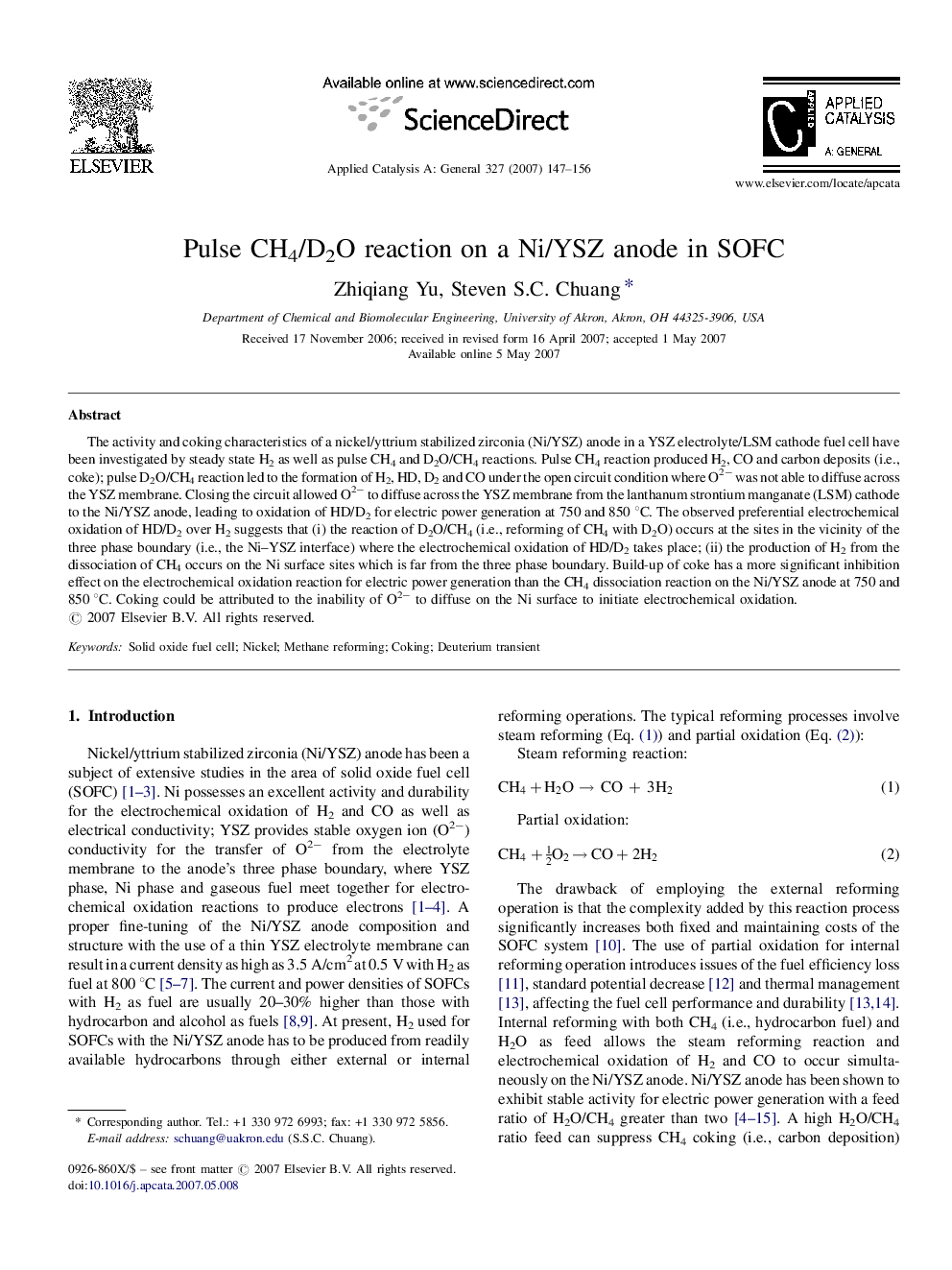| کد مقاله | کد نشریه | سال انتشار | مقاله انگلیسی | نسخه تمام متن |
|---|---|---|---|---|
| 44142 | 46005 | 2007 | 10 صفحه PDF | دانلود رایگان |

The activity and coking characteristics of a nickel/yttrium stabilized zirconia (Ni/YSZ) anode in a YSZ electrolyte/LSM cathode fuel cell have been investigated by steady state H2 as well as pulse CH4 and D2O/CH4 reactions. Pulse CH4 reaction produced H2, CO and carbon deposits (i.e., coke); pulse D2O/CH4 reaction led to the formation of H2, HD, D2 and CO under the open circuit condition where O2− was not able to diffuse across the YSZ membrane. Closing the circuit allowed O2− to diffuse across the YSZ membrane from the lanthanum strontium manganate (LSM) cathode to the Ni/YSZ anode, leading to oxidation of HD/D2 for electric power generation at 750 and 850 °C. The observed preferential electrochemical oxidation of HD/D2 over H2 suggests that (i) the reaction of D2O/CH4 (i.e., reforming of CH4 with D2O) occurs at the sites in the vicinity of the three phase boundary (i.e., the Ni–YSZ interface) where the electrochemical oxidation of HD/D2 takes place; (ii) the production of H2 from the dissociation of CH4 occurs on the Ni surface sites which is far from the three phase boundary. Build-up of coke has a more significant inhibition effect on the electrochemical oxidation reaction for electric power generation than the CH4 dissociation reaction on the Ni/YSZ anode at 750 and 850 °C. Coking could be attributed to the inability of O2− to diffuse on the Ni surface to initiate electrochemical oxidation.
The activity and coking characteristics of a nickel/yttrium stabilized zirconia (Ni/YSZ) anode in a YSZ electrolyte/LSM cathode fuel cell have been investigated by steady state H2 as well as pulse CH4 and D2O/CH4 reactions. Pulse CH4 reaction produced H2, CO and carbon deposits (i.e., coke); pulse D2O/CH4 reaction led to the formation of H2, HD, D2 and CO under the open circuit condition where O2− was not able to diffuse across the YSZ membrane. Closing the circuit allowed O2− to diffuse across the YSZ membrane from the lanthanum strontium manganate (LSM) cathode to the Ni/YSZ anode, leading to oxidation of HD/D2 for electric power generation at 750 and 850 °C. The observed preferential electrochemical oxidation of HD/D2 over H2 suggests that (i) the reaction of D2O/CH4 (i.e., reforming of CH4 with D2O) occurs at the sites in the vicinity of the three phase boundary (i.e., the Ni–YSZ interface) where the electrochemical oxidation of HD/D2 takes place; (ii) the production of H2 from the dissociation of CH4 occurs on the Ni surface sites which is far from the three phase boundary. Build-up of coke has a more significant inhibition effect on the electrochemical oxidation reaction for electric power generation than the CH4 dissociation reaction on the Ni/YSZ anode at 750 and 850 °C. Coking could be attributed to the inability of O2− to diffuse on the Ni surface to initiate electrochemical oxidation.Figure optionsDownload as PowerPoint slide
Journal: Applied Catalysis A: General - Volume 327, Issue 2, 15 August 2007, Pages 147–156